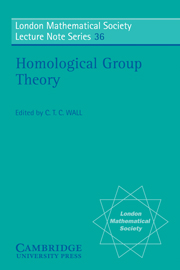Book contents
- Frontmatter
- Contents
- Preface
- Introduction
- 1 Traces and Euler characteristics
- 2 Groups of virtually finite dimension
- 3 Free abelianised extensions of finite groups
- 4 Arithmetic groups
- 5 Topological methods in group theory
- 6 An example of a finite presented solvable group
- 7 SL3(Fq[t]) is not finitely presentable
- 8 Two-dimensional Poincaré duality groups and pairs
- 9 Metabelian quotients of finitely presented soluble groups are finitely presented
- 10 Soluble groups with coherent group rings
- 11 Cohomological aspects of 2-graphs. II
- 12 Recognizing free factors
- 13 Trees of homotopy types of ( m)-complexes
- 14 Geometric structure of surface mapping class groups
- 15 Cohomology theory of aspherical groups and of small cancellation groups
- 16 Finite groups of deficiency zero
- 17 Äquivalenzklassen von Gruppenbeschreibungen, Identitäten und einfacher Homotopietyp in niederen Dimensionen
- 18 Two-dimensional complexes with torsion values not realizable by self-equivalences
- 19 Applications of Nielsen's reduction method to the solution of combinatorial problems in group theory: a survey
- 20 Chevalley groups over polynomial rings
- List of problems
14 - Geometric structure of surface mapping class groups
Published online by Cambridge University Press: 05 April 2013
- Frontmatter
- Contents
- Preface
- Introduction
- 1 Traces and Euler characteristics
- 2 Groups of virtually finite dimension
- 3 Free abelianised extensions of finite groups
- 4 Arithmetic groups
- 5 Topological methods in group theory
- 6 An example of a finite presented solvable group
- 7 SL3(Fq[t]) is not finitely presentable
- 8 Two-dimensional Poincaré duality groups and pairs
- 9 Metabelian quotients of finitely presented soluble groups are finitely presented
- 10 Soluble groups with coherent group rings
- 11 Cohomological aspects of 2-graphs. II
- 12 Recognizing free factors
- 13 Trees of homotopy types of ( m)-complexes
- 14 Geometric structure of surface mapping class groups
- 15 Cohomology theory of aspherical groups and of small cancellation groups
- 16 Finite groups of deficiency zero
- 17 Äquivalenzklassen von Gruppenbeschreibungen, Identitäten und einfacher Homotopietyp in niederen Dimensionen
- 18 Two-dimensional complexes with torsion values not realizable by self-equivalences
- 19 Applications of Nielsen's reduction method to the solution of combinatorial problems in group theory: a survey
- 20 Chevalley groups over polynomial rings
- List of problems
Summary
Introduction
This article will describe some recent progress on the structure of the group Γg of mapping classes for a compact surface Sg of genus g ≥ 2. A mapping-class is an isotopy class of homeomorphisms (usually assumed to be C∞ diffeomorphisms); occasionally it will be convenient to use the alternative definition of it, valid by virtue of Nielsen's theorem, as an element of the outer automorphism group of the fundamental group Π1(Sg).
I shall not attempt here to catalogue the many ways in which these groups impinge on various parts of mathematics, nor will their properties be developed comprehensively. My concern is with two aspects of the theory, which bear a close relationship to each other. One of them is the purely combinatorial study of how Γg operates on the space of simple loops in Sg, and the other is the geometric action as the Teichmüller modular group on the classifying space Tg = T(Sg) of complex structures on the surface Sg. It transpires that in attempting to analyse the boundary structure of T(Sg) and the extended action of Γg on it, one is naturally led to the former question.
My primary aim in the description of Teichmüller space (§ § 3, 4) which forms the basis of this account has been to provide sufficient background to understand the geometric formulation of Thurston's recent theorem on classification of mapping-classes, in terms of both their action on T(Sg) and the dynamical systems determined by them on Sg.
- Type
- Chapter
- Information
- Homological Group Theory , pp. 255 - 270Publisher: Cambridge University PressPrint publication year: 1979
- 24
- Cited by



